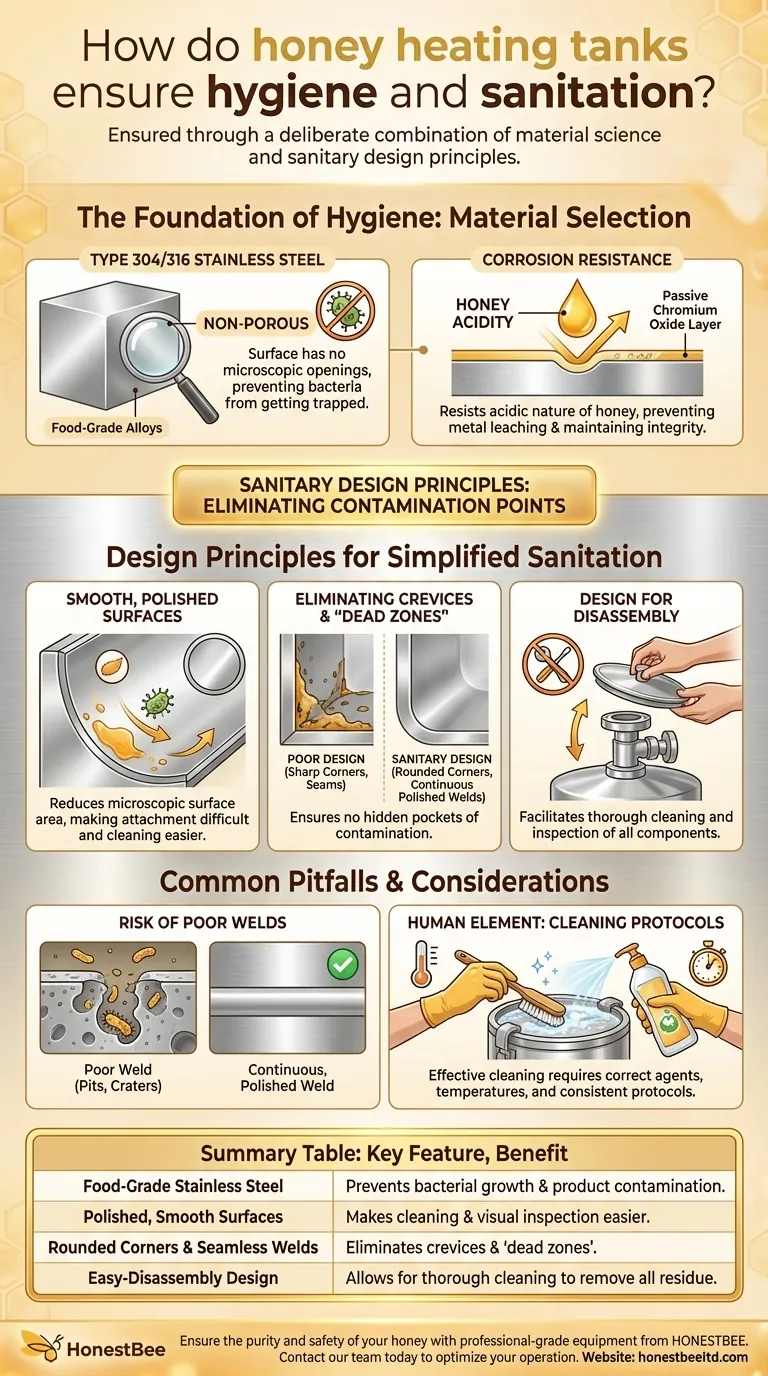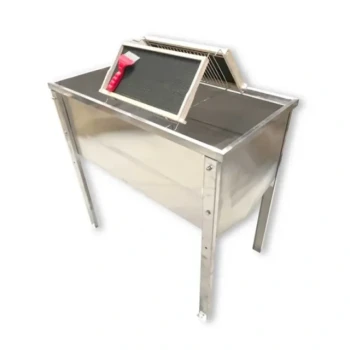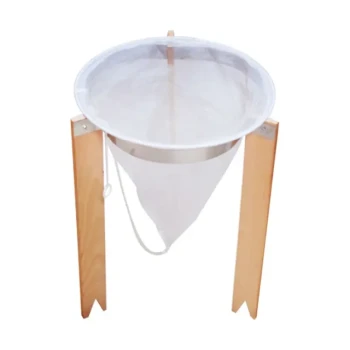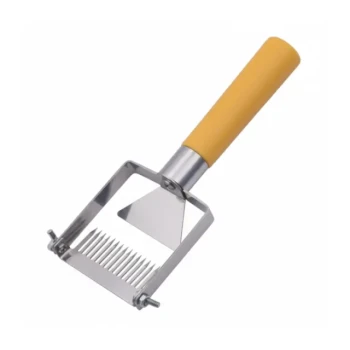Honey heating tanks ensure hygiene and sanitation through a deliberate combination of material science and sanitary design principles. They are almost exclusively constructed from food-grade stainless steel, a material chosen for its non-porous, non-corrosive nature, which prevents the absorption of honey and the growth of bacteria. This construction, coupled with designs that facilitate easy and thorough cleaning, is fundamental to upholding the highest standards of food safety.
The sanitation of a honey heating tank is not merely a feature; it's the core design principle. While stainless steel provides the foundation, true hygiene is achieved through a system-wide focus on eliminating contamination points, ensuring smooth surfaces, and allowing for complete disassembly and cleaning.

The Foundation of Hygiene: Material Selection
The choice of material for any food processing equipment is the first and most critical step in ensuring sanitation. For honey, with its unique chemical properties, this choice is paramount.
Why Stainless Steel is the Industry Standard
Stainless steel is a non-porous material. Unlike wood or plastic, its surface has no microscopic openings where honey residue, bacteria, or other contaminants can become trapped and multiply.
This non-reactive quality also ensures that the material will not impart any metallic taste to the honey or alter its delicate chemical balance, preserving its natural flavor and quality.
The Importance of Corrosion Resistance
Honey is naturally acidic, which can corrode lesser metals over time. Stainless steel contains chromium, which forms a passive, invisible layer of chromium oxide on the surface.
This layer self-repairs when scratched and provides exceptional resistance to the acidic nature of honey, preventing metal from leaching into the product and ensuring the tank's long-term integrity.
Adherence to Food-Grade Specifications
Not all stainless steel is created equal. Honey heating tanks are typically made from specific food-grade alloys, most commonly Type 304 or Type 316 stainless steel. These grades are certified to be safe for direct contact with food products.
Design Principles for Simplified Sanitation
A hygienic tank is one that is designed to be cleaned easily and effectively. Modern sanitary design focuses on eliminating any area where contaminants could linger.
Smooth, Polished Surfaces
The interior surfaces of high-quality honey tanks are polished to a smooth finish. This reduces the microscopic surface area, making it more difficult for bacteria to attach and forming a biofilm. A smoother surface is also significantly easier to wipe clean and visually inspect.
Eliminating Crevices and "Dead Zones"
Sharp corners, seams, and fittings are potential traps for product and bacteria. Sanitary design demands rounded corners and continuous, polished welds.
This construction eliminates the crevices and "dead zones" that are difficult to reach and clean, ensuring that the entire tank can be sanitized without leaving any hidden pockets of contamination.
Design for Disassembly
Valves, gates, and lids are common sanitation challenges. A well-designed tank features components that can be easily and quickly disassembled without special tools. This allows operators to thoroughly clean and inspect each part, ensuring no honey residue is left behind.
Common Pitfalls and Considerations
While a good design provides the capability for hygiene, it does not guarantee it. The operator plays a crucial role in maintaining sanitation.
The Risk of Poor Welds
A primary differentiator in tank quality is the welding. A poorly executed weld can create pits, craters, and crevices along the seam, completely negating the benefits of the stainless steel surface. Always inspect welds to ensure they are smooth, continuous, and fully polished.
The Human Element: Cleaning Protocols
The most advanced tank is only as hygienic as its cleaning procedure. Using the correct, food-safe cleaning agents, proper temperatures, and consistent protocols is essential. The tank's design makes effective cleaning possible, but it is the responsibility of the user to execute it properly.
Making the Right Choice for Your Operation
Choosing the right equipment requires balancing compliance, efficiency, and budget.
- If your primary focus is food safety compliance: Verify the tank is made from certified food-grade stainless steel (Type 304 or 316) and features sanitary, polished welds.
- If your primary focus is operational efficiency: Select a design with easily removable, tool-free components and a sloped or conical bottom to ensure complete draining and faster cleaning cycles.
- If you are operating on a tight budget: Prioritize a high-quality, crevice-free interior surface above all else, as this is the most critical area for protecting your product.
Ultimately, a well-designed honey heating tank is a critical tool that empowers producers to protect the purity and safety of their product with confidence.
Summary Table:
| Key Feature | Hygiene & Sanitation Benefit |
|---|---|
| Food-Grade Stainless Steel | Non-porous, non-corrosive surface prevents bacterial growth and product contamination. |
| Polished, Smooth Surfaces | Reduces surface area for bacteria to attach, making cleaning and visual inspection easier. |
| Rounded Corners & Seamless Welds | Eliminates crevices and 'dead zones' where contaminants can hide. |
| Easy-Disassembly Design | Allows for thorough cleaning of valves, gates, and lids to remove all honey residue. |
Ensure the purity and safety of your honey with professional-grade equipment from HONESTBEE.
For commercial apiaries and distributors, maintaining impeccable hygiene is non-negotiable. Our honey heating tanks are engineered with the sanitary principles detailed above—using premium Type 304/316 stainless steel and designs that facilitate fast, effective cleaning—to protect your product and your brand.
Let us help you optimize your operation with reliable, wholesale-focused equipment. Contact our team today to discuss your needs and request a quote.
Visual Guide

Related Products
- Stainless Steel Heated Honey Tank Warming Heating Tank
- Professional Honey Storage Tank with Agitation System
- Stainless Steel Uncapping Tank with Stand and Strainer
- Stainless Steel Honey Storage and Settling Tank with Double Strainer
- Professional Honey Filter with Tripod Support Stand
People Also Ask
- What are the overall benefits of using a honey heating tank in honey processing? Ensure Quality & Boost Efficiency
- What are the efficiency benefits of using a honey heating tank? Boost Processing Speed & Protect Honey Quality
- What is the purpose of the double-walled stainless steel tank in the honey mixer? Gentle, Even Heat for Quality Honey
- What safety and maintenance tips should be followed when using a honey bucket heater? Ensure Honey Quality and Equipment Longevity
- How does a honey heating tank preserve the quality of honey? Gentle Heat for Purity & Flavor



















